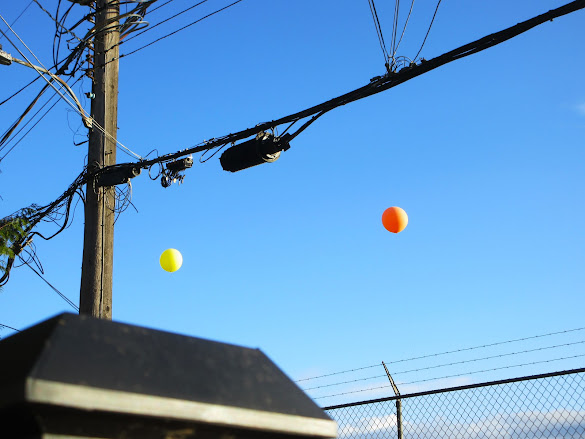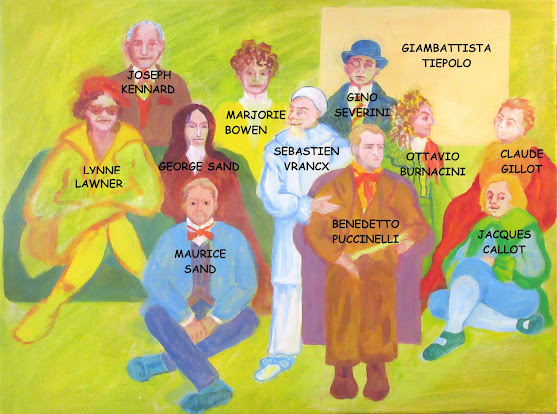Yes, it's happening! -- the wrap party is on, even better and more populated than had been imagined when the original scheme collapsed. You already know some of the Commedia's "enablers" and some, who I'd failed to mention before, have joined the crowd today.
True to definition, they make a motley crew. They're an odd assortment of individuals united by their common connection to the Commedia tradition – in which "motley" garments are essential to Harlequin and his closest associates. After rejecting a formal dinner to honour their contributions, I chose a deliberately informal set-up for the celebration. I like what I've seen on-line of this wonderful young artist's colours and figures and copied some of her poses.
Are you ready for introductions? Pour your drink of choice -- it might be a long evening; we have a lot of ground to cover – several hundred years' worth. Moving roughly left to right in my final painting, you'll meet first Lynne Lawner.
She's an American photographer/scholar, still going strong at 89, and she wrote the most fabulous researched and illustrated book, Harlequin on the Moon.
Next up and preceding Lawner by almost a century is Joseph Spencer Kennard – author of over 25 books on Italian culture and history.
A clever man, indeed, since somehow he's managed posthumously to be almost absent from the internet, except for his book sales. Luckily, this one was available from the Vancouver Public Library:
In it, he writes memorably:
"The Commedia dell'Arte is Art and it is Psychology. It is a theatre of all people, of all arts, of all moments when life wings up out of drab reality. It is a theatre of music and dance; of song, colour and light; of days on wagon stages, of festivals in streets, in courts, in great squares; on rivers; at weddings and funerals and coronations; of actors with and without mass; sometimes in extraordinary costumes.
Many of these actors are unknown to fame; many more are immortal. Paintings, etchings, and engravings have made their faces familiar – diverting, ludicrous, facetious; sometimes grimly, often grotesquely, the Commedia dell'Arte portrays incongruous humanity."
Next, a major contributor to Commedia lore – accompanied by his greatest fan. Maurice Sand single-handedly produced dozens of engravings and paintings that form the definitive illustrations of Commedia performers and their costumes.
You've seen many of these before in this series – and they appear and reappear in the Commedia literature.
His greatest fan? Well, of course – his mother, who adored him. She was the famous French author George Sand, and she arrives at our celebration as a special guest of honour – at an age when Maurice was a young teenager.
Another strong imaginative female joins Lawner and Sand in the person of Marjorie Bowen, who you've met before.
Now, moving to the right side of the eventual painting, you'll meet (or meet again) some lesser-known figures – but by no means, less known in Commedia archives. Here's Sebastien Vrancx.
A prolific painter and engraver of the late 1500s-early 1600s, he produced hundreds of works, not the least of them concerning Commedia figures.
I don't remember how I first came across him, but somehow I put myself on the mailing list of an auction house that every month or so sends me notice that one of his prints is up for sale.
Then – beating of drums, sounding of horns – here's my personal favourite find of this series: Gino Severini.
A 20th century Italian artist, he's responsible for "Two Pulchinelli", the painting on the cover of Lynne Lawner's book.
And then there's – well, this is embarrassing. In late March, I was enjoying my quiet Saturday shift at VanDusen Botanical Gardens' library. I've been spending some of each shift touring and listing its rich selection, shelf by shelf, and was interested enough to pull out a book on invasive plants of the Pacific Northwest. Suddenly – my worlds collided as I found reference to the Puccinellia species of invasive grass!
Was I losing my marbles? When I reached home and searched farther, I found what you've perhaps already realized:-- This was not Pulchinella but rather, the species name derived from the 19th century botanist Benedetto Puccelli. Whew! Close call – marbles found. Here's dignified Benedetto, who turned up at the Enablers' Celebration by some means or another.
Now, on quickly to some formidable early contributors to Commedia lore. Here's Ottavio Burnacini.
And an example of the "grotesques" in which he specialized:
Then Claude Gillot.
And his "Performance by the Commedia dell'Arte".
Another early notable, Jacques Callot.
And his "Pulliciniello."
Yes, the spelling is all over the place, but that's not my doing. Finally (for this round, at least) is Giambattista Tiepolo who is practically the godfather of all these white garbed figures who have shown up anywhere with their long-nosed faces. Here's his "Pulcinelli cooking and tasting gnocchi" – for all you gnocchi lovers out there.
Okay, that's the gang. Here they all are, labelled on a late stage of the painting:
And here's the final painting "Motley Crew" (copyright 2024).
Certainly, some liberties were taken. Burnacini, who was right at home in the royal courts of Europe, has been transformed with dreadlocks.
And Vrancx and Puccelli are barely suppressing their mutual suspicion.
But all in all, there's a lot to celebrate – and I salute all these artists, writers, scholars who have led me to be hooked on the history and artistry that enchanted them.





























No comments:
Post a Comment